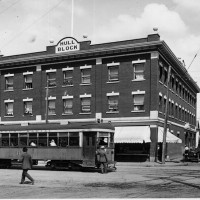The Hull Block: A Restored Historic Landmark
Once condemned, the building now houses upscale apartments.

When Bob Dawe bought the Hull Block in 1999, it had seen better days. The building, at 9664 106 Avenue, had been a major Edmonton landmark since it was constructed in 1914. But after many decades of changes in the city, Dawe says it was “a complete disaster, with a rabbit warren of small rooms on the upper floors.” The city had condemned the residential spaces, but several long-standing businesses were still operating on the main floor.
“You couldn’t believe the mess,” Dawe says. There were many broken windows, which allowed pigeons to move in. He remembers scaring the birds out with a tennis racket. There were mice too. As well, homeless people had been breaking in to spend the night.
“I like historic things,” says Dawe, Assistant Curator, Archaeology, at the Royal Alberta Museum. “Maybe I thought I was a visionary.”
Dawe hired Architect David Murray to lead his restoration and renovation project. Murray, working with HIP Architects, developed a conservation plan consisting of several phases. Murray’s goal was to keep the structure “as authentic as possible.” But, Murray says, the building had to be changed considerably to meet current building codes and standards. Also, it is extremely costly to replicate the materials and labour/craftsmanship that were used a century ago.
The first step was to restore the exterior and improve the main-floor retail spaces. The exterior retains the Late Edwardian Commercial style: red brick with numerous ornate details.
Next, the many small rooms were redesigned to create 10 condominium apartments. As originally constructed in 1914, the now upscale apartments consisted of many rooms, with every wall serving as a structural support. To create the open-plan structure that allowed a reconfiguration of the suites, Murray had to find ways to replace all the internal structural walls with a series of beams and columns.
The last phase of construction was parking lot development and roof-top amenities: a deck with a hot tub, change area, large TV, and washrooms. As well, the 40-foot flagpole, removed in 1939, was reinstated. “The flag can be seen for miles,” Dawe says.
Murray, who specializes in historic buildings, enjoyed the job. “Every building has a story,” he says, “and it is fun to explore those stories. It was a tremendous opportunity to work on this beautifully appointed structure.”
“I am happy I did it,” Dawe says. But he also mentions his disappointment with what he describes as the city’s lack of progress. On the streets around the building, there are significant drug problems and other social issues. “I had hoped for a more family-friendly environment,” he says.
Watch The Hull Block on YouTube
For more details about the history and architectural style of the building, see the YouTube video, The Hull Block here.
Who Constructed the Hull Block?
The Hull Block was constructed by William Roper Hull, a Calgary businessman who built Calgary’s Grain Exchange, Alberta Block, Albion Block, and Opera House. The Hull Block has both municipal and provincial historical resource designations.
Anita Jenkins is a retired writer and editor who lives in Boyle Street.



